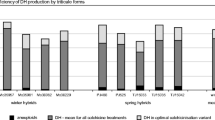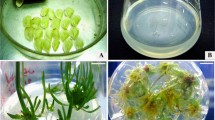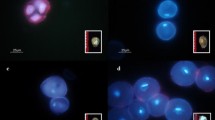Abstract
The present study was an attempt to develop an in vitro colchicine chromosome doubling protocol to restore the fertility of an F1 interspecific hybrid in Lilium. Basal scale segments of Lilium × formolongi × Oriental hybrid (FO) bulblets were pre-cultured for three durations (6, 15 and 25 days) and soaked in three colchicine concentrations (0.00, 1.25 and 2.50 mM) for 18, 24 and 36 h. To separate mixoploids, three cycles of adventitious bud induction were performed. The ploidy levels of the surviving plantlets were detected by flow cytometry at 30–31 weeks after induction and were confirmed by chromosome counts. The results indicated that the pre-culture duration, colchicine concentration and exposure time all had significant impacts on the tetraploid induction rate. The preferred procedure was to pre-culture the segments for 6 days and then treat them with 1.25 mM colchicine for 24 h. The morphological traits of rosette leaves were significantly different between the tetraploid and diploid plants. The adult tetraploid plants had considerably longer and wider leaves, larger flowers, and delayed flowering time (8 days later) than did diploid plants. Pollen viability tests and backcross trials of FO hybrids demonstrated fertility restoration at the tetraploid level. This protocol provides a feasible method for inducing fertile tetraploid FO hybrids for further breeding.







Similar content being viewed by others
References
Abu-Qaoud H, Skirvin RM, Chevreau E (1990) In vitro separation of chimeral pears into their component genotypes. Euphytica 48:189–196
Anderson NO, Younis A, Optiz E (2009) Development of colored, non-vernalization -requiring seed propagated lilies. Acta Hortic 836:193–198
Anssour S, Krügel T, Sharbel TF, Saluz HP, Bonaventure G, Baldwin IT (2009) Phenotypic, genetic and genomic consequences of natural and synthetic polyploidization of Nicotiana attenuata and Nicotiana obtusifolia. Ann Bot 103:1207–1217
Bakhshaie M, Babalar M, Mirmasoumi M, Khalighi A (2010) Somatic embryogenesis and plant regeneration of Lilium ledebourii (Baker) Boiss., an endangered species. Plant Cell Tissue Organ Cult 102:229–235
Bakhshaie M, Khosravi S, Azadi P, Bagheri H, Van Tuyl JM (2016) Biotechnological advances in Lilium. Plant Cell Rep 35:1799–1826
Barba-Gonzalez R, Ramanna MS, Visser RGF, Van Tuyl JM (2005) Intergenomic recombination in F1 lily hybrids (Lilium) and its significance for genetic variation in the BC1 progenies as revealed by GISH and FISH. Genome 48:884–894
Barba-Gonzalez R, Lim KB, Van Tuyl JM (2014) Molecular cytogenetics in Lilium breeding. Acta Hortic 1027:129–142
Bi WL, Chen L, Guo L, Pan C, Yin ZF ,Wang QC (2015) Plant regeneration via embryo-like structures: histological observations and genetic stability in regenerants of Lilium spp. J Hortic Sci Biotech 90:626–634
Chandanie MA, Singh SK, Sindhu SS, Singh A, Tomar SMS, Prasad KV (2011) Efficacy of oryzalin as a potent chemical for in vitro induction of polyploids in Asiatic lily (Lilium hybrida L.) var. Polyanna. India J Genet 71:262–268
Dhooghe E, Denis S, Eeckhaut T, Reheul D, Van Labeke MC (2009) In vitro induction of tetraploids in ornamental Ranunculus. Euphytica 168:33–40
Dhooghe E, Van Laere K, Eeckhaut T, Leus L, Van Huylenbroeck J (2011) Mitotic chromosome doubling of plant tissues in vitro. Plant Cell Tissue Organ Cult 104:359–373
Doležel J, Greilhuber J, Suda J (2007) Estimation of nuclear DNA content in plants using flow cytometry. Nat Protoc 2:2233–2244
Gomes SSL, Saldanha CW, Neves CS, Trevizani M, Raposo NRB, Notini MM, Santos MDO, Campos JMS, Otoni WC, Viccini LF (2014) Karyotype, genome size, and in vitro chromosome doubling of Pfaffia glomerata (Spreng.) Pedersen. Plant Cell Tissue Organ Cult 118:45–56
Han DS, Niimi Y (2008) Fertility restoring of interspecific hybrids between Lilium nobilissimum and L. regale by chromosome doubling. Acta Hortic 766:421–426
Hu FR (2007) The wild and artificial germplasm assessment by cytogenetics and mass propagation system establishment in Lilium. PhD thesis, Nanjing Forestry University, Beijing
Lim KB, Van Tuyl JM (2002) Identification of parental chromosomes and detection of ribosomal DNA sequences in interspecific hybrids of Lilium revealed by multicolor in situ hybridization. Acta Hortic 570:403–408
Lim KB, Chung JD, Van Kronenburg BCE, Ramanna MS, Hans de Jong J, Van Tuyl JM (2000) Introgression of Lilium rubellum Baker chromosomes into L. longiflorum Thunb.: a genome painting study of the F1 hybrid, BC1 and BC2 progenies. Chromosome Res 8:119–125
Lim KB, Wennekes J, Jong JHd, Jacobsen E, Van Tuyl JM (2001) Karyotype analysis of Lilium longiflorum and Lilium rubellum by chromosome banding and fluorescence in situ hybridisation. Genome 44:911–918
Murashige T, Skoog F (1962) A revised medium for rapid growth and bio assays with tobacco tissue cultures. Physiol Plant 15:473–497
Ning Y, Zhou H, Wang F (2003) The bulblet morphogenesis of Lilium × formolongi in scale propagation. Acta Hortic 30:229–231
Okazaki K (1996) Lilium species native to Japan, and breeding and production of Lilium in Japan. Acta Hortic 414:81–92
Omran A, Mohammad BN (2008) Polyploidization effect in two diploid cotton (Gossypium herbaceum L. and G. arboreum L.) species by colchicine treatments. African. J Biotechnol 7:102–108
Regalado JJ, Carmona-Martín E, Castro P, Moreno R, Gil J, Encina CL (2015) Study of the somaclonal variation produced by different methods of polyploidization in Asparagus officinalis L. Plant Cell Tissue Organ Cult 122:31–44
Rhee HK, Kim KS (2008) Interspecific hybridization and polyploidization in lily breeding. Acta Hortic 766:441–445
Rose JB, Kubba J, Tobutt KR (2000) Chromosome doubling in sterile Syringa vulgaris × S. pinnatifolia hybrids by in vitro culture of nodal explants. Plant Cell Tiss Organ Cult 63:127–132
Roy AT, Leggett G, Koutoulis A (2001) In vitro tetraploid induction and generation of tetraploids from mixoploids in hop (Humulus lupulus L.). Plant Cell Rep 20:489–495
Schwarzacher T, Heslop-Harrison JS (2000) Reprobing of preparations. In: Kingston F (ed) Practical in situ hybridization, BIOS Scientific Publishers Limited. Oxford, UK, p 110
Takamura T, Lim KB, Van Tuyl JM (2002) Effect of a new compound on the mitotic polyploidization of Lilium longiflorum and Oriental hybrid lilies. Acta Hortic 572:37–40
Takayama S, Misawa M (1980) Differentiation in Lilium bulbscales grown in vitro. Effects of activated charcoal, physiological age of bulbs and sucrose concentration on differentiation and scale leaf formation in vitro. Physiol Plant 48:121–125
Van Tuyl JM, Lim KB (2003) Interspecific hybridisation and polyploidisation as Tools in ornamental plant breeding. Acta Hortic 612:13–22
Van Tuyl JM, Van Holsteijn HCM (1996) Lily breeding research in the Netherlands. Acta Hortic 414:35–45
Van Tuyl JM, Van-Holsteijn HMC, Kwakkenbos AAM (1990) Research on polyploidy in interspecific hybridization of lily. Acta Hortic 266:323–330
Van Tuyl JM, Meijer B, Van Diën MP (1992) The use of oryzalin as an alternative for colchicine in in vitro chromosome doubling of Lilium and Nerine. Acta Hortic 325:625–630
Van Tuyl JM, Van Dijken A, Chi HS, Lim KB, Villemoes S, Van Kronenburg BCE (2000) Breakthroughs in interspecific hybridization of lily. Acta Hortic 508:83–90
Xu CP, Huang Z, Liao T, Li Y, Kang XY (2016) In vitro tetraploid plants regeneration from leaf explants of multiple genotypes in Populus. Plant Cell Tissue Organ Cult 125:1–9
Yan HJ, Xiong Y, Zhang HY, He ML (2016) In vitro induction and morphological characteristics of octoploid plants in Pogostemon cablin. Breeding Sci 66:169–174
Yin ZF, Zhao B, Bi WL, Chen L, Wang QC (2013) Direct shoot regeneration from basal leaf segments of Lilium and assessment of genetic stability in regenerants by ISSR and AFLP markers. In Vitro Cell Dev Biol- Plant 49:333–342
Zhang J, Zhang M, Deng XX (2007) Obtaining autotetraploids in vitro at a high frequency in Citrus sinensis. Plant Cell Tissue Organ Cult 89:211–216
Zhou SJ (2007) Intergenomic recombination and introgression breeding in Longiflorum × Asiatic lilies. Ph D thesis, Wageningen University, The Netherlands
Acknowledgements
The work was supported by grants from the National Forestry Public Welfare Industry Research Project (201204609) and the National Natural Science Foundation of China (31470106).
Author contributions
The authors have made the following declarations regarding their contributions: GXJ, XQZ conceived and designed the experiments; XQZ, QZC performed the experiments; and XQZ analyzed the data and wrote the manuscript.
Author information
Authors and Affiliations
Corresponding author
Ethics declarations
Conflict of interest
The authors declare that they have no conflicts of interest.
Rights and permissions
About this article
Cite this article
Zhang, X., Cao, Q. & Jia, G. A protocol for fertility restoration of F1 hybrid derived from Lilium × formolongi ‘Raizan 3’ × Oriental hybrid ‘Sorbonne’. Plant Cell Tiss Organ Cult 129, 375–386 (2017). https://doi.org/10.1007/s11240-017-1184-9
Received:
Accepted:
Published:
Issue Date:
DOI: https://doi.org/10.1007/s11240-017-1184-9




